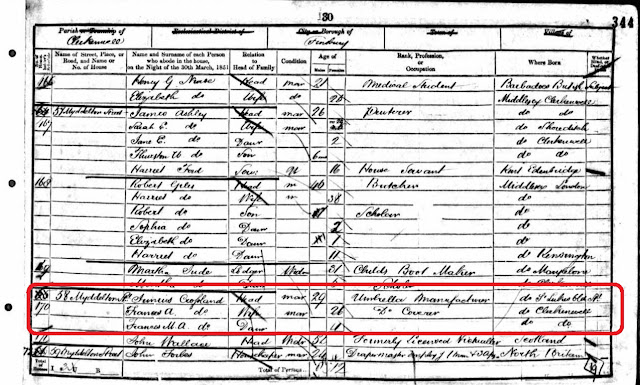Francis Ann Otton was born in London, England on February 8, 1824. This document shows her baptism in Middlesex County a few months after she was born.
Francis was the daughter of Ralph Churchill Otton and Elisabeth Kent Otton. As a girl, her chief occupation was making umbrellas. She attended the English grammar school for a limited time and later worked in an umbrella factory. Her meager earnings contributed to the support of the Otton family.
Francis Ann married Junius Crossland on May 29, 1841 at a Parish Church in London. She was seventeen years of age at the time of her marriage. Three of their children were born in London; namely, Amelia, Francis and Eliza Luff.
Francis in the England 1851 Census with Junius and their oldest daughter Francis
Francis heard the gospel preached and was converted to The Church of Jesus Christ of Latter-day Saints in her native land and the entire family was baptized. In 1853, the Crosslands sold their possessions in London and left England against the wishes of her parents and seven brothers, and came to America on the ship International. She emigrated to Utah with the Jacob Gates Company. More information regarding the Jacob Gates Company can be found at the LDS Church History site. She is listed as a member of the company here.
The crossing of the plains was extremely difficult for Francis. One month from the date the ship arrived in New Orleans, Louisiana, a daughter Emma Elizabeth was born May 30, 1853 at Keokuk, Iowa to Frances and Junius Crossland. Three days later, with Frances confined to her bed in the wagon, the family joined the Jacob Gates Company to emigrate to Utah.
At the Bear River, while Mrs. Crossland was still confined to her bed in their wagon, her husband died of Mountain Fever and was given a hasty burial in the wilderness of the plains. His grave is located near what is known today as Evanston, Wyoming.
The following excerpt from James Ririe's trail journal can be found at the
LDS Church History Site:
Francis settled in the Seventeenth Ward, in salt Lake City, where she continued her trade of making umbrellas. It was also necessary for her to take in washings in order to support her four children. Washings at that time were done by hand, as there were no washing machines. This was very hard on her, as she was frail and having come from a well to do family in England, was not used to such work.
It was during this time that the saints endured the “Grasshopper Famine”. She has often told the story of one dark rainy day when they found themselves hungry and without food, the famine having reached the stage where starvation seemed inevitable. That night the mother and children knelt down and prayed to the Lord for assistance. In the morning, the back yard was full of segos, which seemed to have sprung up over night. The family lived on these segos for several weeks and felt they had been greatly blessed.
In 1858, Francis Crossland married William Adams, abandoning her little Salt Lake home and moved to Utah County. She took her four daughters and went to the home of Mr. Adams to care for his three children, and his aged mother, who was blind and almost helpless. William Adams died on October 6, 1898.
Francis in the US 1880 Census with William and her youngest son Joseph Hyrum
Francis Crossland Adams was always a good neighbor and a willing church worker. She aided a great deal in caring for the sick of the settlement. She rode for miles, as a Relief Society worker, to care for the helpless, the sick and the needy. She was always active in The Church of Jesus Christ of Latter-day Saints and she served as a Relief Society teacher in the Pleasant Grove Ward from the time of its organization until her death.
Francis Ann Otton died on January 23, 1903 and is buried in the Pleasant Grove, Utah Cemetery. The coordinates of the headstone are N 40° 22.131 W 111° 44.458, marked with a green arrow on the map below. Francis Crossland is my 3rd Great Grandmother on the Goodman side of the family. The last name on the headstone, "William H. Adams" is her step son.
View Larger Map





















































